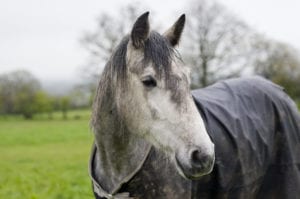Caring for and Preventing Rain Rot on Horses
Do you own horses? Or are you thinking about getting your first horse soon? Horses are fun and fascinating companions, but they have many unique health needs that have to be met. They are also prone to developing health issues related to their hygiene and living conditions. One of these problems is known as rain rot.

Rain rot on horses is a type of bacterial infection of the skin. If your horse comes down with a skin condition you think might be rain rot, you should address this problem as soon as possible.
Read through the article below to learn more about rain rot as well as how to care for and prevent it.
What Causes Rain Rot on Horses?
Rain rot is a condition that is caused by the presence of bacteria on the skin. The bacteria responsible for the infection is called dermatophilus congolensis. It lives on the skin and then, when the opportunity arises, infects the skin due to the presence of other problems. For example, if there is damage to the skin, the bacteria take that chance to enter the skin and spread.
There are several causes that may lead to an infection from this type of bacteria. Some of the problems that can lead to rain rot on horses include:
Biting Insects
When insects bite your horse, they break the skin and may allow bacteria to enter.
High Heat
Heat causes the skin to become weak and damaged, allowing the bacteria to find a way in.
High Humidity or Excess Moisture
Too much moisture encourages the growth of bacteria on and within the skin.
Other Skin Lesions
If your horse has a scratch, bite, or abrasion on her skin, she may be more likely to develop rain rot.
Long or Dark Hair
Horses with long hair or dark hair develop mats in their hair and may develop scabbing related to rain rot. When the scabs come off, pus usually oozes out of these sores.
If you think your horse is suffering from this condition, it’s extremely important to find out for sure. When your horse has a positive rain rot diagnosis, it’s time to think about how to care for the condition.
Caring for Rain Rot on Horses
Some horse owners prefer to leave rain rot to clear up on its own over time. It is possible for this condition to rectify itself, especially if the underlying cause is addressed or removed. For example, if moisture is causing the problem, keeping your horse dry until the sores clear up can be enough of a solution for many people.
However, the sores can potentially spread and may get worse before they get better. They also cause a lot of pain, which can contribute to behavioral changes and may prevent your horse from being able to be ridden. For these reasons, it may be prudent to address this problem with your horse rather than waiting for the condition to clear up.
Gently Bathe Your Horse
To treat rain rot, you will first need to bathe the horse gently to remove the scabs from the sores. This may be painful for your horse, so practice caution; if she is in pain, she may kick.
After bathing, make sure to dry her thoroughly. Otherwise, the presence of too much moisture on the skin may prolong the condition.
Apply Appropriate Helpful Products
Moderate to severe cases of rain rot on horses may need to be treated with an antibiotic. However, some prefer to look for alternatives when caring for their animals.
Curicyn offers an equine wound and skin care product that is specifically designed to address these types of skin problems on animals. Created with the intention of promoting rapid healing for conditions such as rain rot, this product causes little to no scarring. In addition, it does not cause any burning, itching, or staining for your animal.
How to Prevent Rain Rot on Horses
Prevention is key when it comes to many horse skin conditions, including rain rot. It’s not difficult to prevent your horse from developing this problem, but it may take some changes to the way you stable or ride her.
Daily Grooming
Daily grooming is an important factor in preventing your horse from developing rain rot. Brush her very frequently and make sure the brushes are kept clean. Do your best to reduce sources of insects in her stable and field, and to keep those insects from biting her as much as possible.
Stay Out of Humid, Muggy or Wet Environments
Keep your horse out of very humid, muggy, or wet conditions. If her stable is always moist, do what you can to fix the problem and keep her dry when she’s stabled. If there are portions of her field that are very muddy or always damp, try to prevent her from using these areas whenever possible.
Wash and Dry Thoroughly After Muddy Rides
If you ride your horse through the mud or rain, wash and dry her thoroughly afterward. And if she does end up with a case of rain rot, make sure you keep her separated from other horses, as the condition can spread very easily.
Use Different Tools for Non-Infected Horses
It’s also important to use different tack and grooming items for horses that do not have this condition. Otherwise, you may risk cross contaminating your healthy horses and causing the problem to take over very quickly.
Disinfect any items that come into contact with the affected horse regularly.
Address Rain Rot on Horses As Soon As Possible
By paying attention to your horse’s needs, you’ll be better able to keep her healthy and happy. Although rain rot may seem like an overwhelming problem when it happens to you and your horse, it’s still a condition that can be addressed and cared for properly.
Remember, too, that rain rot may mimic the symptoms of some other skin conditions so it’s important to find out if your horse has been impacted by this.
Curicyn offers a variety of products that promote rapid healing for many skin conditions your horse may contract. If you have any questions about our products or how they can help your animal, feel free to contact us any time. We’re proud to be your partner in your animal’s health. Find your closest Curicyn retailer for additional access to our products.
In addition to our wound and skin care product, Curicyn offers other products that can help with equine skin conditions. Curicyn’s fly spray for horses product helps protect your horse from bugs and insects that could lead to different skin conditions, such as ticks, fleas and gnats. Moreover, we also offer an equine first aid kit that contains all the products you need should your horse develop a skin condition when on the road. It’s also something that can be kept in your horse’s stable so everything you need is in one place.
